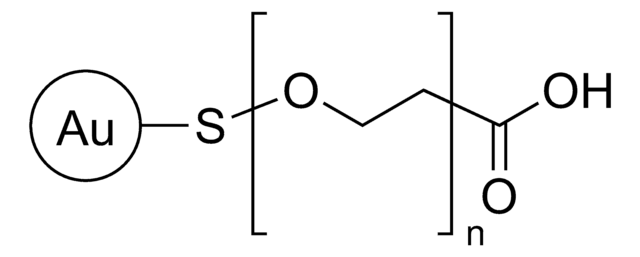765430
Gold nanoparticles
5 nm diameter, carboxylic acid functionalized, PEG 3000 coated, OD 50, dispersion in H2O
Synonym(s):
Gold nanoparticles COOH functionalized, Au NP COOH, Gold Colloid
Select a Size
Select a Size
About This Item
Recommended Products
material
PEG 3000
Quality Level
form
dispersion in H2O
nanoparticles
packaging
poly bottle of 1 mL
OD
50
diameter
5 nm
pH
6.0-8.0 (25 °C)
solubility
water: miscible
density
1.00 g/cm3
λmax
515 nm
Looking for similar products? Visit Product Comparison Guide
Related Categories
General description
Application
AuNPs may be used to prepare SARS-CoV-2 conjugate for COVID-19 detection using lateral flow immunoassay technique.[3][4] It may also be used in the immobilization of antibodies to improve the sensitivity of optical fiber sensors for the screening of COVID-19.[5] It can also be deposited on the titanium electrode for the formation of a miniaturized device for the electrochemical detection of DNA hybridization.[5]
Storage Class Code
12 - Non Combustible Liquids
WGK
WGK 2
Flash Point(F)
Not applicable
Flash Point(C)
Not applicable
Choose from one of the most recent versions:
Certificates of Analysis (COA)
Don't see the Right Version?
If you require a particular version, you can look up a specific certificate by the Lot or Batch number.
Already Own This Product?
Find documentation for the products that you have recently purchased in the Document Library.
Articles
Biomaterials science involves the design and fabrication of smart materials for studying, directing, or mimicking biology. For successful integration of biomaterials in biological research, a meaningful understanding of biological systems is required.
Our team of scientists has experience in all areas of research including Life Science, Material Science, Chemical Synthesis, Chromatography, Analytical and many others.
Contact Technical Service